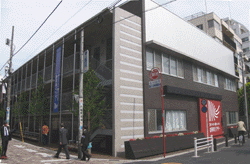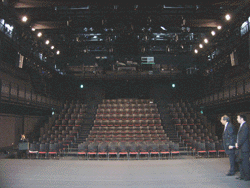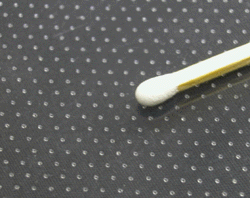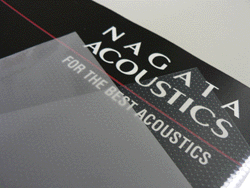
Title means "Quietness", "Comfortable Sound" and "Excellent Acoustics"
Nagata Acoustics News 05-07 (No.211)
Issued : July 25, 2005
Kichijoji Theatre Opens
by Makoto Ino
Facade of Kichijoji Theatre
 |
On May 21, 2005, Kichijoji Theatre officially opened, and on June 11, the play "Uncle Karafuto," by playwright Uishin Chon, began the theater's inaugural run. The new theater is just a five-minute walk from the north exit of Kichijoji Station, a very accessible location in the affluent and arts-conscious Tokyo suburb of Musashino City.
Musashino City, with a population of 130,000, borders the west side of Tokyo proper, adjoining Tokyo's Suginami Ward. Musashino City spreads to the north of the JR rail line, which traverses the city along its southern end, stopping at Kichijoji, Mitaka, and Musashi-sakai. Kichijoji is the closest of the three stations to downtown Tokyo, making it Musashino City's eastern gateway to the Tokyo metropolis. The ride from JR Shinjuku Station to Kichijoji is a mere 13 minutes, and from Shibuya, the Keio Inokashira Line brings riders to Kichijoji in just 16 minutes.
Kichijoji's convenient location and the prevalence of upscale housing contribute to the area's economic vitality. Department stores and fashionable boutiques line a web of streets that extend from Kichijoji Station's north exit, and it is also a favorite gathering place of students and young professionals.
<< Musashino City's Vibrant Cultural Life >>
Considering Musashino City's relatively small size, the city supports a substantial number of performing arts venues. The city has the centrally located Musashino Civic Cultural Hall, which has a 1,354-seat multipurpose hall and a 474-seat concert hall with a pipe organ. In the southern part of the city, at Mitaka Station, the Musashino Performing Arts Theater stages primarily traditional Japanese performing arts genres and has a capacity of 154 seats. On the city's west side, across from JR Musashi-sakai Station, the 180-seat Musashino Swing Hall caters to jazz and rock concerts, and at the south exit of Kichijoji Station, Musashino Public Hall provides another 350-seat venue. The Musashino Cultural Foundation maintains and operates all these facilities.
The new Musashino Theatre thus adds a venue specifically designed for contemporary plays and dance performances to the city's cultural assets. It would be difficult to find another local Japanese government that has as specifically and consciously targeted construction of performing arts facilities as has Musashino City. While the city's vibrant cultural life owes something to the city's proximity to Tokyo and the affluence of its residents, the excellent city planning and the city's sincere and serious approach to fostering the performing arts also deserve much credit for the success of the city's programs and facilities.
<< The Project's Participating Companies >>
Veteran theater consultant Theater Workshop developed Kichijoji Theatre's conceptual plans and provided executive oversight for the technical design and installation of the stage equipment. Naomi Sato Architects, winners of a design competition held for the project, created the building's architectural design. P.T. Morimura & Associates, Ltd. designed the theater's technical engineering needs and Nagata Acoustics served as acoustical consultant.
The city contracted the project's construction and design execution to local companies that mostly had no previous experience with a hall project. The construction contractor was Shiraishi Kensetsu Corp. Morihei Stage Construction built the structural elements of the stage, Matsushita Electric Works, Ltd. created the stage lighting and Panasonic System Solutions Engineering Co., Ltd. provided the stage sound system.
<< Overview of the Kichijoji Theatre Facility >>
Inside of the theater
 |
The Kichijoji Theatre building's main feature is the playhouse, which has an open studio design and is ringed by a 1.8m. (6 ft)-wide corridor that encircles the playhouse on the first and second floors, for a box-within-a-box-style architectural design. The playhouse occupies most of the first and second floors of the theater building, which also has an 80 sq. m. (861 sq. ft) rehearsal room, two dressing rooms and a cafe.
The theater's fundamental design uses an end-stage configuration. Tiered rows of seating allow for a maximum capacity of 197 patrons and, if the seating is removed, the flat-floored space accommodates 239 persons.
The stage has dimensions of 12.7 m. (42 ft) width and 7.2 m. (24 ft) depth. Most of the stage floor is constructed using "kumiyuka" wood panel floor techniques, including a 1.8 m. (6 ft)-deep area below the stage's floor. A vertical shutter at the rear of the stage separates the stage from an area 5 m. (15 ft) wide and 8 m. (26 ft) deep that extends to the theater's loading dock. The ability to keep the shutter raised during performances is a special feature that enables the extended space to be incorporated into a play or other production's stage setting in order to increase the three-dimensional perspective of the set.
The theater's equipment includes three rows of technical bridges above the stage and three rows above the audience seating area, for a total of six technical bridges. Between the technical bridges, 2-to-3 electrically operated batons provide ample rigging and the theater also has a suspended apparatus for blowing special effects into the air. The height from the stage to the technical bridge measures 7.1 m. (23 ft).
At the left and right sides of the theater are two tiers of balconies that face toward the audience seating. The lower tier (on the building's second floor) connects with the top tier of the main audience seating at the rear of the theater and provides additional audience seating. The upper balcony, on the building's third floor, serves as a technical gallery. The stage lighting controls and sound system console are located in the rear portion of the third floor balcony.
<< Criteria for the Acoustics of Kichijoji Theatre Playhouse >>
Theater professionals typically speak with one voice regarding playhouse acoustics. They want "clarity along with good acoustics." The planners of most existing playhouses prioritized the elimination of flutter echoes and other sound phenomena that negatively impact clarity, with the result that most playhouses have rather dead acoustics. The close proximity of audience seating to playhouse stages makes this approach possible.
The new Kichijoji Theatre's audience seating area has only 11 rows, with the last row located just 10 m. (33 ft) from the front of the stage. However, even at a distance of 10 m. (33 ft) from a sound source, direct sound attenuates 20 dB. This level of attenuation means that, at 10 m. from the sound source, a soft-spoken voice may become difficult to hear and comprehend. Experienced actors can be expected to use speaking techniques that project their voices and simultaneously create an impression of soft or whispered speech. But since some of Kichijoji Theatre's performers will be actors still new to their craft, we decided to design the theater's walls to provide some sound reflection and thereby ensure that actors' voices will be heard clearly even in the last row of the playhouse.
Because the project's programming and anticipated use plans include modern dance performances and concerts by popular music bands, our acoustical design necessarily included a sound reinforcement (SR) system with loudspeakers capable of reproducing loud sound. Typically, we make sound absorption a key element of our room design when implementing these kinds of SR systems. However, for the Kichijoji Theatre project, a robust sound absorption design would conflict with need for the theater to reflect sound during unamplified theatrical performances. We recognized these two competing requirements at the outset of our work on the project and addressed this challenge in our design solution.
<< Acoustical Design Solution for Kichijoji Theatre Playhouse >>
Sidewall treatments:
The playhouse's original interior design specified walls of exposed wood-fiber-concrete panels, a sound-absorbing material typically used for concrete forms. Wood-fiber concrete is a durable material, and this characteristic would make it appropriate for a theater interior, except that it also absorbs primarily the same mid-range frequencies that characterize the human voice. In order to obtain sound reflecting surfaces where we needed them, we covered 50% of the surfaces we designated as sound reflecting with diatomite and we also used diatomite on top of about 30% of the remaining wall surfaces. We determined where and how much diatomite to use by measuring the reverberation time on site while the diatomite was being applied.
In addition, to prevent flutter echoes on the theater's second floor, we angled the upper portions of the sidewalls outward.
Balanced sound absorption and reverberation time:
The kumiyuka stage materials and the fine spaces between wood pieces absorb low frequency sound, while the wood-fiber cement panels absorb mid-frequency sound. Also, the glass fiber installed at a portion of the ceiling, the playhouse equipment, the ductwork, the stage curtain and the audience absorb high frequency sound. Through the combination of these sources of sound absorption, we created a balanced sound absorption characteristic in the theater. As a result, the theater's reverberation time exhibits minimal variation across the spectrum of sound frequencies.
At 500 Hz, with the seating unoccupied, and without the stage curtain, the theater's reverberation time measures 1.2 seconds (in actual, on-site testing). Based on the measured value, we estimate the reverberation time in the fully occupied theater to be 1.0 second. With these acoustical results, the reverberation time in unoccupied conditions may seem slightly long. Nevertheless, the acoustics have a smooth, clean quality. For some performance genres, the theater may need to do some minor fine-tuning of the acoustics, but the achieved reverberation time will enable the theater to be used as an open studio for a wide variety of events and performances.
<< Kichijoji Theatre's Immediate Popularity >>
According to Kichijoji Theatre Executive House Manager Yuji Minoshima, even though the theater limits its closed days to one per month, the theater's rental calendar is already 97% booked well into the future. Mr. Minoshima happily counts as his major concerns figuring out how to give theater employees their days off and finding windows of opportunity for the theater's maintenance.
Many performers will soon bring their creative talents to this new playhouse and the theater's appealing acoustics will impact artistic expression and experimentation on the venue's stage. As the theater's operations reach their stride, I look forward to seeing each aspect of the theater used to its full potential.
More information about Kichijoji Theatre and Musashino Cultural Foundation can be found at the foundation's website, located at http://www.musashino-culture.or.jp/idx_english.html
A Symposium on: "Do Concert Halls Have a Future?"
by Dr. Minoru Nagata, Nagata Acoustics Chairman Emeritus
On Thursday, May 19, 2005, the Japanese Association for Concert Hall Networking held a symposium entitled "Do Concert Halls Have a Future?" at Nasunogahara Harmony Hall in Tochigi Prefecture. Three sessions comprised the symposium. The first session, "Family Concert for Age 0 and Up," was an innovative daytime concert open to the public. The second session was the symposium's keynote address, given by Nasunogahara Harmony Hall Director Masaaki Niwa, who spoke on "The State of Concert Halls Today and Current Concerns." For the third session, a five-person panel discussed aspects of the question posed by the symposium's title, that is, whether classical music concert halls have a viable future in Japan. As the acoustical consultants on concert hall construction projects, the symposium's focus bears great relevance to our company and our profession, so I made sure to attend. Nagata Acoustics' Akira Ono also attended with me.
<< Keynote Address: "Concert Halls Today and Current Concerns" >>
Mr. Niwa began his keynote address by explaining the purpose and organization of the Japanese Association for Concert Hall Networking, then talked about its past vitality and current challenges. Since its establishment in 1991, the association has organized annual conferences, making the 2005 symposium the association's 14th annual event. At the time that the association's founders conceived the association, many of Japan's small and rural cities, towns and suburbs were sponsoring the construction and operational management of local concert halls. It was an era when observers both inside and outside Japan's classical music industry predicted a bright future ahead for the industry and people inside the industry gave their dreams free rein. At its height, the association counted representatives from 65 concert halls among its annual conference participants. In 2005, only 26 concert halls participated, telling a clear story about the industry's current difficult situation. With the number of cultural facilities in Japan now exceeding the 2,000 mark, to have only 26 of these institutions participate in Japan's annual classical music industry conference is a sad state of affairs.
<< 2002 and the Chilling of the Japanese Classical Music Landscape >>
The Japanese classical music industry's dreams of the early 1990s evaporated within less than a decade. In February 2002, the Japan Association of Classical Music Presenters (a for-profit organization) sponsored a symposium at Tokyo Bunka Mura's Cocoon Theatre with the title "Is the Classical Music Industry Headed for Extinction?" It was around the same time that the owners of Casals Hall announced the hall's closing, and a chill pervaded the air among industry professionals who sensed the advent of narrowed opportunities.
The Japan Association of Classical Music Presenters' February 2002 symposium opened with presentations on the Aix-en-Provence International Music Festival and the University of Michigan's Classical Music Society, both examples of success stories that increased their communities' interest in and attendance at classical music concerts. I remember that as I watched these presentations, I was struck by the contrast between the vitality of the classical music industry in Europe and the United States versus the lukewarm nature of the industry in Japan.
<< The May 19, "Do Concert Halls Have a Future?" Panel Discussion >>
The May 19, 2005 symposium's panelists included music critic, Mr.Yoshihiko Kusakabe, Bach Hall vice executive director, Mr. Tadayuki Shimizu, impresarios, Mr. Masayuki Sekita and Mr. Jun Taki, and the popular young classical pianist, Miss Chika Nagisa. Collectively, these panelists know the world of classical music through their activities "on the ground" at concert halls, managing, performing or attending and reviewing classical music concerts. Given their areas of expertise, the panelists concentrated their discussion on topics such as performers' guaranteed fee, the role of concert hall curators charged with creating and devising new programs to attract patrons, and the development of hall management system. The panelists did not consider the role of the physical concert hall building and its facilities, nor did they directly address the future of classical music in Japan.
<< Reversing the Ebb of Classical Music in Japan's Next Generation >>
During classical music's recent heyday in Japan, Tokyo earned the reputation of having a "bull market" for classical music concerts, but that vigor is gone. I also hear less these days about the concert activities of a number of regional halls that previously sponsored and organized concerts well worth the trip from Tokyo.
In contrast to the tepid atmosphere in some quarters of the Japanese classical music world, Nasunogahara Harmony Hall's "Family Concert for Age 0 and Up," held as the kickoff event of the May 19 symposium, demonstrates some concert halls' active cultivation of the next generation. This kind of programming offers encouragement for the future.
There was a spring event this year aimed to promote interest in attending classical music concerts among a broader audience. During the first three days of the "Golden Week" holiday, at five of Tokyo International Forum's seven halls, the Forum sponsored La Folle Journee au Japon ("Days of Enthusiasm Music Festival") 2005. Held in cooperation with the French Embassy, the French Ministries of Foreign Affairs and of Culture and Communications, and the City of Nantes, the festival presented "Beethoven and His Fellows," a series of concerts featuring the works of Beethoven. With tickets priced at just 1,500 yen (about US$13.00 or 11 EUR), the festival drew crowds of patrons wanting to experience classical music in the trendy setting of Tokyo's International Forum complex (located in the Marunouchi business district.)
In this coming autumn a concert of Berlin Philharmonic Orchestra headed by Sir Simon Rattle, who has developed the education project to introduce classical music to youths since his inauguration as Principal Conductor and Artistic Director of the orchestra in 2002, will be held at NHK Hall. There will be the youth discount tickets for 500 seats allowing young people to come to the hall and enjoy the music at less expensive price. Such a movement by the orchestra and sponsor to bring up the future classical music fans is highly praised.
Each person experiences his or her first encounter with classical music in a uniquely personal way. Surely, that first encounter includes a remarkable interaction of the human senses with the music, but in this age of abundant sensory stimuli, our awareness of how music affects us is diminished. Some young adults say that the only time they listen to music is when they are driving in their cars, that is, when they are also doing something else. How Japan's classical music inheritance will be received by Japan's next and future generations, and whether they will return Japan's classical music world to its former exuberance are the two questions that, when answered, will have huge implications for the future of classical music in Japan.
Advances in Perforated Panels - Part 2: Microperforated Panels
by Dr. Keiji Oguchi
In this article, I will introduce our readers to the scientific basis, and practical applications of microperforated panels (MPP). MPP come in foils, sheets and panels, and are characterized by having a 0.5 - 2.0% ratio of perforations to solid area and sub-millimeter, cylindrical perforations manufactured with uniform patterns and tolerances.
<< Characteristics of MPP >>
MPP hole & Match head
 |
When a MPP, sheet or foil is placed in front of a rigid, sound-reflecting surface (such as a wall), with a layer of air between the surface and the MPP, the air mass inside the microperforations and the air spring caused by the layer (or cavity) of enclosed air together form a Helmholz resonator. (A simple example of a Helmholz resonator is the resonance heard when a person blows across the top of a soda-pop bottle, making the air trapped in the bottle into an air spring.) Helmholz resonators generate resonance at specific frequency ranges. The resonant frequencies of MPP currently available are mid-range frequencies of 250 Hz - 1kHz.
A key difference between the perforated panels I discussed in my May 2005 article, "The Science, Uses and Advances in Perforated Panels -- Part 1" and MPP is the tiny size of the holes, which measure less than 1 mm in diameter. Because of the holes' extremely small size, when the air within the hole vibrates and converts from sound to heat energy, marked sound absorption occurs for frequencies in the resonance vicinity, eliminating the need for backings of porous sound-absorbing materials such as glass wool, provided the sound frequencies needing to be absorbed are within the 250 Hz - 1kHz range. A practical application of the phenomenon is that a sheet or panel of MPP can be set in front and slightly apart from a wall and the configuration will absorb mid-range frequencies. Furthermore, if transparent MPP are used, the resulting configuration is a visually transparent sound-absorbing solution.
<< The Seminal Work of Prof. Maa >>
Transparency of MPP foil
 |
The suggestion to use microperforations comes from Prof. Dah-You Maa, Research Professor at the Institute of Acoustics, Academia Sinica in 1975. I first learned about microperforations in 1992, at the 14th International Congress on Acoustics in Beijing. The conference presentation I attended lasted less than 20 minutes, and did not enable me to fully grasp all of the details and ramifications of Prof. Maa's work, but the salient point I gleaned from that presentation was the feasibility of a transparent sound absorbing material.
In the years following the Beijing International Congress on Acoustics presentation, research into the applications of sound absorbing structures continued, especially in China and Germany, and the research produced numerous papers. Among the research is a paper in which the relatively easy analogy of an equivalent electrical circuit is used to discuss the sound-absorbing structure of microperforations. In the analogy using an equivalent circuit, the method considers a circuit that exchanges a mechanical element for an electrical element. When substituting the equivalent circuit for the absorption that occurs with microperforations, the electrical coil represents the air mass in the holes, the electrical condenser represents the air spring (of the air layer between the MPP and the rigid surface), and the conversion of vibration energy to heat is represented by electrical resistance, building the equivalent circuit of the analogy.
<< Practical Applications of MPP >>
Currently, use of MPP in Japan is dependent on supplies of MPP from Europe and the United States, because there is no local Japanese manufacturer of the material at the moment. European and U.S. suppliers manufacture MPP from metals, polycarbonates, Teflon, acrylics and flame-retardant plastics. By using transparent or translucent MPP, it becomes possible to achieve some level of sound absorption performance even in spaces that are primarily enclosed by glass surfaces.
As I mentioned earlier in this article, MPP exhibit a selective sound absorption characteristic concentrated on absorption of mid-range frequencies. By using multiple layers of MPP with different hole diameters and different distances between the holes, the effective sound absorption range can be expanded to a wider range of frequencies. (This technique is documented in L. Cremer et al: "Principles and Applications of Room Acoustics.") In addition, research by Asst. Prof Sakagami of Kobe University demonstrates that if two sheets or panels of MPP are placed with an air cavity between them, sound absorption of lower frequencies can be obtained. (One possible room acoustics application might be to suspend the two layers from an overhead structure.) These creative suggestions for expanding the usefulness of MPP, make me increasingly hopeful that this technology will continue to lead to many useful research breakthroughs and the development of useful products.
One example of a supplier of MPP products can be found at: http://www.kaefer.com/neuhome/Microsorber_neu/microsorber.htm
E-mail Distribution of Nagata Acoustics News & Opinions
We hope you have enjoyed this News & Opinions newsletter, available each month on our web-site (http://www.nagata.co.jp). We also offer e-mail delivery of the text version of this newsletter. To receive the text newsletter to your e-mail address, simply send the following information to us at newsmail_e@nagata.co.jp:
(1) Your e-mail address
(2) Your name
(3) The name of your company
By requesting the text version via e-mail, you will automatically receive every newsletter and you can still get the visuals and graphics at our web-site.
Nagata Acoustics News 05-07 (No.211)
Issued : July 25, 2005
Nagata Acoustics Inc.
Hongo Segawa Bldg. 3F, 2-35-10
Hongo, Bunkyo-ku, Tokyo 113-0033 Japan
Tel: +81-3-5800-2671, Fax: +81-3-5800-2672
(US Office)
2130 Sawtelle Blvd., Suite 307A,
Los Angeles, CA 90025, U.S.A.
Telephone: (310) 231-7818
Fax: (310) 231-7816
E-mail: info@nagata.co.jp






